Is Canned Tuna Healthy? 9 Benefits & Risks
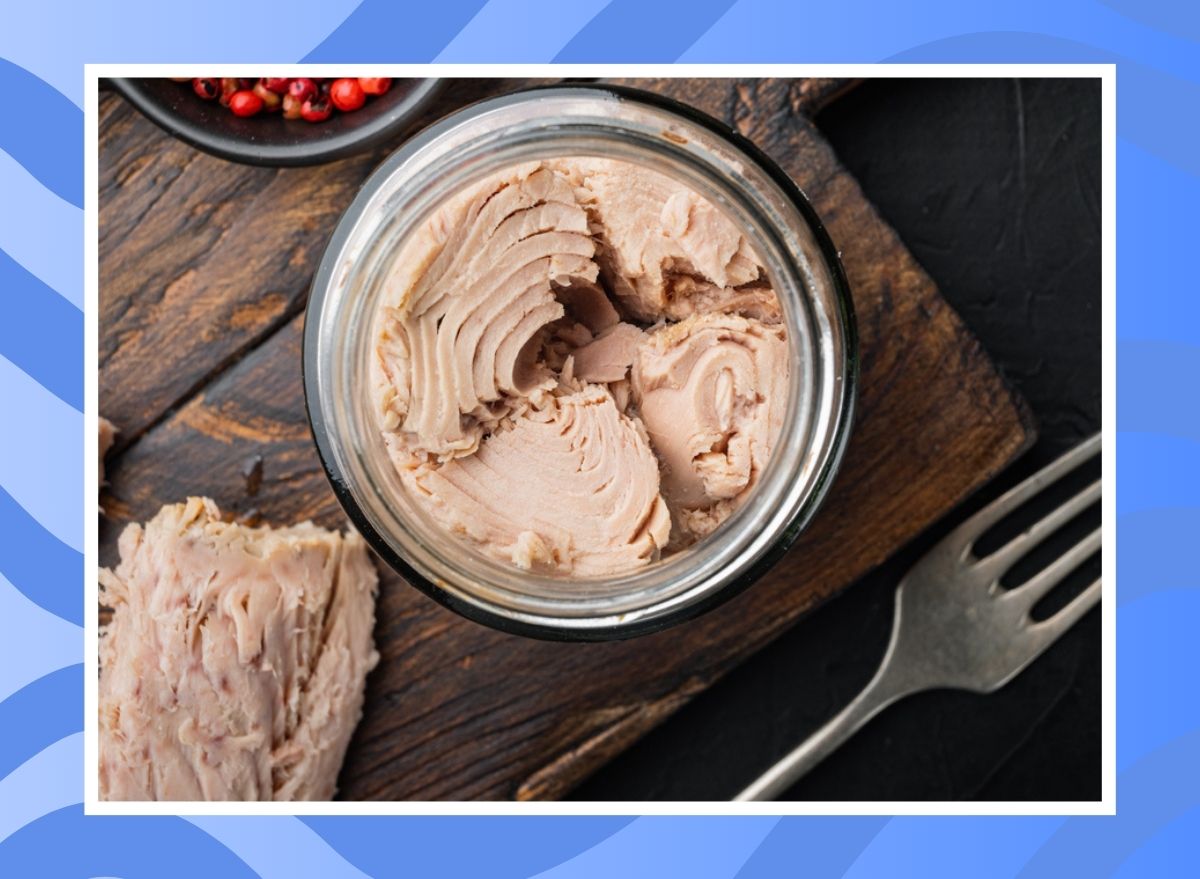
Fish is one of the healthiest foods, providing protein, healthy fats, and a wide range of rich nutrients. Oven-baked salmon filets or a seared ahi tuna steak can be delicious ways to enjoy this healthy food, but buying fresh fish can be expensive, and it may not be an option for everyone. Because of this, many people turn to canned tuna for an affordable, convenient way to eat fish. But is canned tuna healthy? Or do the potential risks outweigh the positives?
“Canned tuna is a nutritious, low-fat source of lean protein and omega-3 fatty acids, rich in vitamins and minerals, and its versatility allows it to be used in salads, sandwiches, pasta dishes, and various other meals, making it a convenient and healthy pantry staple,” says Lisa Young, PhD, RDN. However, a few risks also come with eating canned tuna, like eating too much sodium or being exposed to mercury. And with all these opposing thoughts about eating tuna from a can, many people may wonder if it’s worth eating.
To learn more about whether canned tuna is healthy or if you’re better off leaving it on the grocery store shelf, read on to learn its benefits and possible side effects. Then, check out these 15 Healthy Canned Tuna Recipes for Weight Loss.
Canned Tuna Nutrition
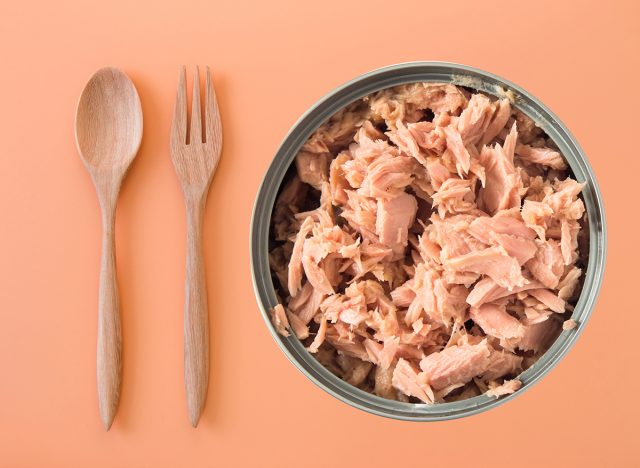
You’ll find a variety of different types of canned tuna in the store, such as Albacore, Yellowfin, and Skipjack, and while the different species, brands, and styles of canned tuna will vary in nutrition, all canned tuna varieties will remain somewhat similar in terms of the nutrients they provide. In a standard can of tuna, according to the USDA, you’ll find:
Calories: 98
Fat: <1 g (Saturated Fat: 0 g)
Sodium: 43 mg
Carbs: 0 g (Fiber: 0 g, Sugar: 0 g)
Protein: 22 g
Along with the nutrients mentioned above, canned tuna is packed with micronutrients like vitamins and minerals. Tuna provides iron, selenium, iodine, niacin (vitamin B3), folate (vitamin B9), and vitamin B12, and we’ll discuss the specific benefits of some of these vitamins in more depth in this article.
Benefits of Canned Tuna

You’ll get a boost of protein.
When you think of protein, your mind may go straight to eggs, chicken, beef, and so on—but don’t forget about fish! One of the main benefits of eating canned tuna is that it is an affordable, easy way to get a protein boost. In fact, a whole can has about 40 grams of protein, with a 3-ounce serving containing around 20 grams.
Tuna is also considered a complete protein, which means it carries all nine essential amino acids, and not all protein sources do. For instance, while fish, eggs, poultry, beef, tofu, and tempeh are complete proteins, things like nuts, vegetables, and legumes are incomplete. This doesn’t mean that incomplete proteins aren’t important. It’s just necessary to get a combination of both. Not only does tuna contain a lot of protein, it’s actually made up almost entirely of this nutrient. This fish is extremely low in fat and carbohydrates and is made up of around 90% protein. The amount of protein alone is a strong argument for why tuna is healthy.
It contains omega-3 fatty acids.
Like many other types of fish and seafood, canned tuna is high in omega-3 fatty acids, and this healthy type of fat has a lengthy list of potential benefits. For one, studies have shown that dietary consumption of omega-3s can help with depression symptoms and overall mood, as well as helping to slow age-related cognitive decline. Recent research reports have also concluded that omega-3s can help with cardiovascular health by lowering cholesterol, helping to reduce blood clots and lower inflammation.
Because of these healthy omega-3 fatty acids found in fish like tuna, the American Heart Association recommends two servings of fish per week. Canned tuna is the perfect choice to meet this suggestion quickly and easily.
It’s low in calories.
Tuna is a protein source for people watching their calorie intake because it is lower in calories than many other animal protein sources. For example, a 3-ounce serving of steak has around 230 calories and a serving of chicken thighs has around 200 calories, while a serving of canned tuna has less than 100 calories and still provides over 20 grams of protein.
It’s rich in vitamins and minerals.
Canned tuna is packed with helpful vitamins and minerals. For instance, you can get a boost of B vitamins, such as B3 (niacin), B9 (folate), and B12. These B vitamins can help provide energy, metabolize proteins, form DNA, and help with overall brain function.
Canned tuna is also high in selenium, a mineral that helps increase the production of white blood cells. This can improve heart, immune, and brain health.
It’s convenient and cost-effective.
At the end of the day, one of the best benefits of eating canned tuna is its affordability and convenience. In a perfect world, you’d always have the time and money to eat fresh fish, but fresh fish is more expensive and time-consuming to prepare. Canned tuna has a long shelf life, allowing you to stock up and have it on hand when needed. It’s also more affordable at around $1-$6 per can than fresh tuna filets, which sometimes cost around $20-$25 per pound.
Potential Side Effects
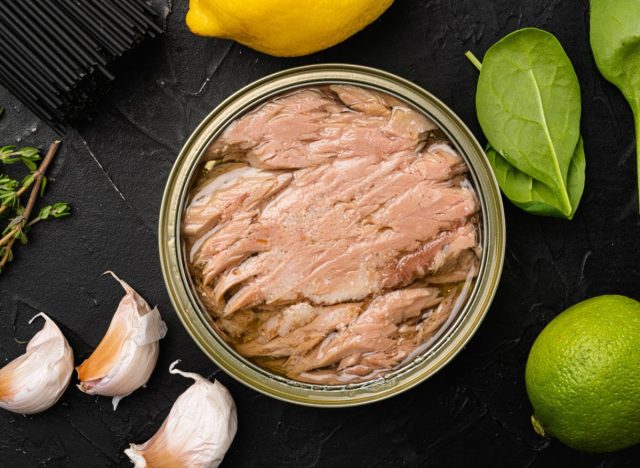
You might eat too much sodium.
When thinking about whether or not tuna is healthy, one potential side effect to consider is that many brands are heavy on sodium. For example, a 3-ounce serving of Bumble Bee White Albacore Tuna has 320 milligrams of sodium, and Chicken of the Sea has 360 milligrams. Eating high amounts of sodium from time to time shouldn’t have much of an effect on your health, but consistently eating too much sodium can lead to high blood pressure and cardiovascular issues.
This amount of sodium may not seem like a lot at first. However, with the recommended daily allowance being no more than 2,300 milligrams of sodium, a canned tuna-centric snack can easily cause you to go above your daily limit. For a lower-sodium canned tuna option, try something like Genova Premium Albacore Tuna.
You can consume a lot of fat in one sitting.
Canned tuna comes in water or oil, and while the oil varieties have a bigger flavor and a more moist texture, they can often pack in a bit too much fat for one snack. Take Target brand Premium White Albacore Tuna, for example. Although it’s sitting in 10 grams of olive oil, a heart-healthy oil known to help lower the risk of cardiovascular disease, it can also contribute to too much total fat in one sitting.
According to the Dietary Guidelines for Americans, 20-35% of your daily diet should be fat, between 44 and 78 grams on a 2,000-calorie diet. As you can see, 10 grams in a can of tuna is a large chunk of your daily recommended value.
Mercury poisoning is a possible risk.
A common question about canned tuna is whether or not people will risk mercury poisoning, which research shows can lead to cognitive impairment and memory loss. The short answer is yes, there’s a mercury exposure risk when you eat canned tuna, but different varieties contain different mercury levels.
According to Consumer Reports, the five most popular tuna brands (Wild Planet, Bumble Bee, StarKist, Chicken of the Sea, and Safe Catch) all contained certain levels of mercury. However, albacore across all brands contained more mercury than skipjack or light varieties on average. CR also found concerning and unexpected spikes of mercury that occurred throughout six of the 30 cans, and there weren’t any predictable patterns with these spikes.
Also, according to the journal Environmental Research, the selenium in tuna actually has protective qualities against the mercury found in tuna and other fish.
You may consume other contaminants and additives.
Besides worrying about potential mercury exposure, it’s also important to note that you may consume contaminants like BPA when you eat canned tuna. BPA (Bisphenol A) is a material found in many cans and plastic bottles that protects the container from breaking. Some people believe that this material is fairly harmless, but some research has also shown that there may be potential risks of BPA exposure, such as an increased risk of endocrine diseases.
Is Canned Tuna Good for You?
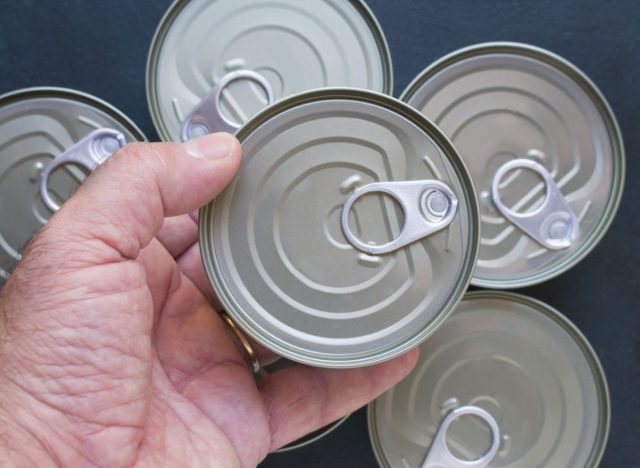
There’s a lot to consider before making yourself a tuna salad sandwich. Canned tuna is high in helpful nutrients like protein and omega-3 fatty acids, as well as powerful vitamins and minerals like B vitamins and selenium. Even though you risk exposure to things like mercury and BPA, you can look for more trustworthy brands and varieties using our tips above.
Incorporating canned tuna into your diet a couple of times a week can boost your body’s valuable nutrients in a super affordable, convenient way. So, if you choose the best brands, this food can be a very tasty, healthy option.
Safe Consumption Tips
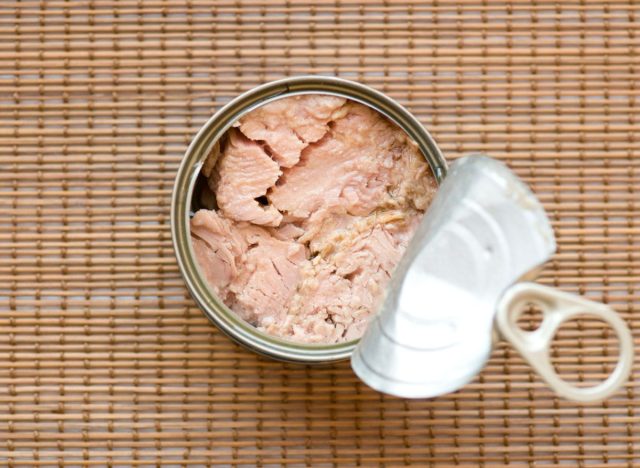
Choosing the Right Type of Tuna
When it comes to choosing the right type of tuna, it often comes down to people’s comfort levels with potential mercury exposure. For instance, white tuna—also known as albacore—can have up to three times the amount of mercury as skipjack tuna, which is used in most “light” canned tuna products. So, if you’re worried about mercury, you’ll be better off sticking to light tuna and avoiding albacore when possible.
Moderation and Serving Sizes
The FDA says it’s safe and beneficial for your health to eat two to three servings (usually 4 ounces) of fish per week, including canned tuna. However, they also recommend eating a variety of fish instead of relying on canned tuna. This can give you a wider range of nutrients and help you limit your exposure to contaminants.
According to the FDA, it’s also safe for pregnant women and women who are breastfeeding to eat canned tuna, but they suggest steering clear of albacore and sticking to light tuna so that you can reduce the risk of mercury exposure.
What Is the Healthiest Canned Tuna To Buy?
We’ve already discussed the differences between white and light tuna, but there are a few other things to consider when choosing the healthiest canned tuna brands. You’ll also want to look at whether the tuna is packed in water or oil, as that will affect the overall flavor and calorie content. When you can, opt for companies with sustainable fishing practices.
To help you find the best brands, we’ve picked 12 of the healthiest canned tuna brands at the grocery store.
- Source: https://fdc.nal.usda.gov/fdc-app.html#/food-details/171986/nutrients
- Source: https://fdc.nal.usda.gov/fdc-app.html#/food-details/175158/nutrients
- Source: https://health.clevelandclinic.org/do-i-need-to-worry-about-eating-complete-proteins/
- Source: https://www.ncbi.nlm.nih.gov/pmc/articles/PMC8313386/
- Source: https://www.ncbi.nlm.nih.gov/pmc/articles/PMC8854294/
- Source: https://www.ncbi.nlm.nih.gov/pmc/articles/PMC7827286/
- Source: https://www.heart.org/en/healthy-living/healthy-eating/eat-smart/fats/fish-and-omega-3-fatty-acids
- Source: https://fdc.nal.usda.gov/fdc-app.html#/food-details/168722/nutrients
- Source: https://fdc.nal.usda.gov/fdc-app.html#/food-details/173625/nutrients
- Source: https://fdc.nal.usda.gov/fdc-app.html#/food-details/171986/nutrients
- Source: https://health.clevelandclinic.org/b-vitamin-benefits
- Source: https://ods.od.nih.gov/factsheets/Selenium-HealthProfessional/
- Source: https://www.hsph.harvard.edu/nutritionsource/salt-and-sodium/
- Source: https://www.consumerreports.org/health/food-safety/how-worried-should-you-be-about-mercury-in-your-tuna-a5041903086/
- Source: https://www.sciencedirect.com/science/article/abs/pii/S0013935115001425?via%3Dihub
- Source: https://pubmed.ncbi.nlm.nih.gov/25813067/
- Source: https://www.fda.gov/food/consumers/questions-answers-fdaepa-advice-about-eating-fish-those-who-might-become-or-are-pregnant-or#:~:text=Is%20this%20okay%3F-,Yes.,are%20at%20a%20reduced%20price.









